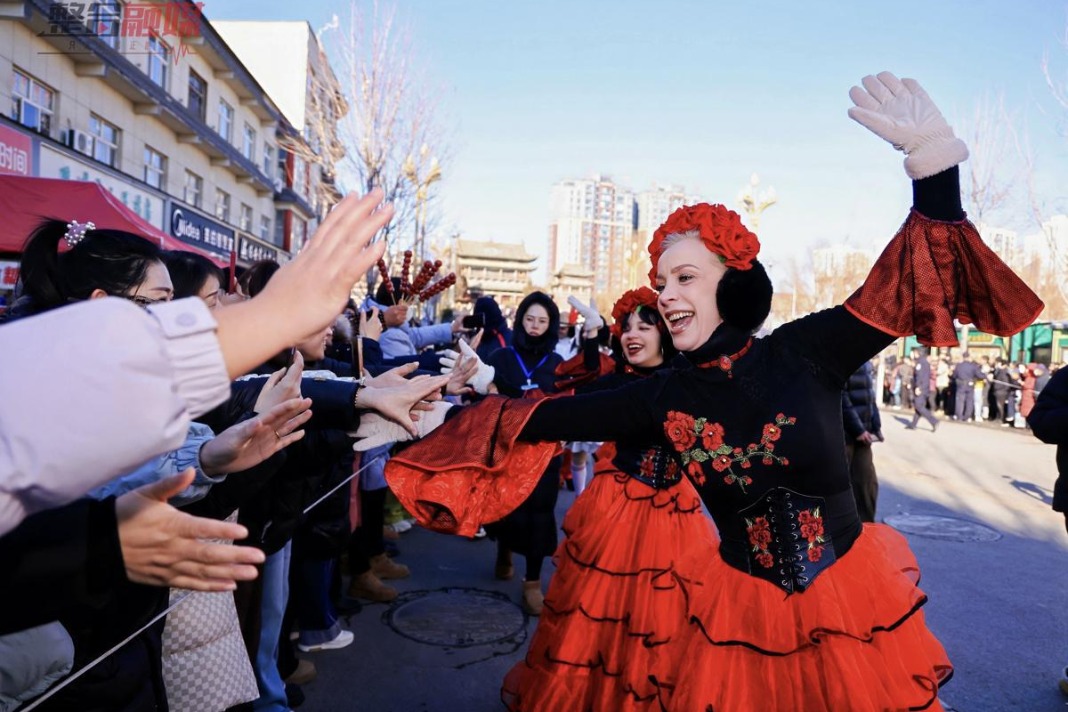CPC Policies on the Governance of Xizang in the New Era: Approach and Achievements
The State Council Information Office of the People's Republic of China November 2023
China Daily | Updated: 2023-11-11 12:11

III. Solid Progress in Ethnic and Religious Undertakings
Developing a stronger sense of the Chinese nation as one community is the Party's top priority in managing ethnic affairs in the new era and a strategic task in governing Xizang. Committed to this mission, the region has strengthened its work related to ethnic affairs and consolidated the socialist ethnic relationship of equality, solidarity, mutual assistance, and harmony. It manages religious affairs in accordance with the law, fully guarantees freedom of religious belief, maintains harmony and stability in the religious field, and helps religion to adapt to the socialist society.
– Heightening the sense of Chinese identity
A shared sense of belonging for the Chinese nation has been consolidated. Xizang has compiled and published textbooks and readers on ethnic solidarity and progress, such as The Readers on Building a Stronger Sense of National Identity. Communication platforms featuring internet plus ethnic solidarity have been launched. The One Nation One Dream campaign was conducted in an effort to guide all ethnic groups to understand that they are in a community with shared joys and sorrows, and weal and woe. During major celebrations such as the Serf's Emancipation Day, the Peaceful Liberation Day of Xizang, and the Month for Promoting Ethnic Solidarity and Progress, Party and government departments, schools, enterprises, public institutions, and urban and rural communities organize popular activities such as knowledge contests and cultural performances on ethnic solidarity and progress. A theme park has been built to present a visual image of the Chinese nation as one community, creating a strong bond among all ethnic groups and inspiring them to move forward in unity and solidarity.
Exchanges, communication and integration among ethnic groups have been strengthened. Local communities in the region have formed multi-ethnic neighborhoods, where people of various ethnicities reside, learn from each other, and enjoy life together. A number of exemplary multi-ethnic harmonious neighborhoods (residential communities/families) mixing Han, Tibetan, Hui, and Mongolian people, such as the Wabaling community in Lhasa, have emerged. Puna Village in Qewa Township of Rinbung County, Xigaze City, is a newly established settlement of 59 households from diverse ethnic backgrounds. The villagers spontaneously included the term "solidarity" into the community regulations and agreed to host a solidarity forum annually for consultation on common development.
China has promoted mutual learning and common progress among students of all ethnicities. In 17 provinces and municipalities that provide assistance to Xizang, employment service and liaison offices have been set up for graduates of Xizang universities to find employment or business opportunities beyond their own region. The graduate employment rate has been maintained above 95 percent for years. Large household businesses in crop and animal farming, entrepreneurs, and agriculture-related businesses are encouraged to invest in Xizang. The autonomous region today is a place for unity, common prosperity and development among all ethnic groups.
– Further promoting ethnic solidarity and progress
Work to facilitate ethnic solidarity and progress has been carried out effectively. Efforts have been made to establish model communities of ethnic unity and progress to promote exchanges and integration of various ethnic groups. Tours have been organized to such cities and counties. In 2020, the region promulgated the Regulations on Building a Model Region for Ethnic Solidarity and Progress in the Xizang Autonomous Region. In 2021, the Plan for Building a Model Region for Ethnic Solidarity and Progress in the Xizang Autonomous Region (2021-2025) was introduced. At the national level, 140 groups and 189 individuals in Xizang were honored by the State Council as models of ethnic solidarity and progress. Seven cities/prefectures including Lhasa were recognized as national demonstration cities. The story of Raidi, recipient of the national honorary title Outstanding Contributor to Ethnic Solidarity, was widely disseminated. People across the region were encouraged to emulate sisters Drolkar and Yangzom as models of the times for ethnic solidarity.
The fight against infiltration, subversion and secession continues. In accordance with the general requirements of safeguarding national security and the region's specific circumstances, and upholding the rule of law in the governance of the region, Xizang adopts a proactive approach to combat secessionism. The reactionary nature of the Dalai Group has been exposed and denounced, and the regional government relies closely on the people of all ethnicities to resist all forms of secession and sabotage. It is now deeply rooted in the people's minds across the region that unity and stability are a blessing, while division and unrest lead to disaster. They are ever more determined to safeguard the country's unity, national sovereignty, and ethnic solidarity.
– Fully guaranteeing the freedom of religious belief
Religious activities are carried out in an orderly manner. The region today hosts over 1,700 sites for Tibetan Buddhism activities, approximately 46,000 Buddhist monks and nuns, four mosques, about 12,000 native Muslims, and one Catholic church with over 700 believers. Over 1,700 religious and folk activities including the Shoton Festival, Butter Lamp Festival, Saga Dawa Festival, and the walks around lakes and mountains help to preserve the solemn traditional rituals and demonstrate new vitality with modern cultural elements. Reincarnation of living Buddhas is a practice recognized and respected by the government at all levels. In 2007, the State-Issued Measures on the Management of the Reincarnation of Living Buddhas of Tibetan Buddhism stipulated the principles that should be followed, the conditions that should be met, and the application and approval procedures that should be implemented. It also specified that reincarnated Tibetan living Buddhas, including Dalai Lamas and Panchen Rinpoches, must be looked for within the country, decided through the practice of lot-drawing from the golden urn, and receive approval from the central government. The reincarnation of living Buddhas has been carried out in an orderly manner ever since. In 2016, an online system has been launched to help obtain information about living Buddhas. By the end of 2022, 93 newly reincarnated living Buddhas have been approved and recognized.
Public services at monasteries and temples have been effectively guaranteed. Much work has been done since 2015 to promote the construction of medical clinics in monasteries and temples, train doctor-monks, improve the social security system for monks and nuns, raise their social security benefits year by year, and provide them with social public services. The government provides over RMB26 million per annum to cover medical insurance, pension schemes, subsistence allowances, accident injury insurance, and health check expenses for all registered monks and nuns. Great efforts have gone into improving infrastructure in monasteries and temples to modernize study and living conditions for monks and nuns; most monasteries and temples now have access to roads, telecommunications, electricity, water, radio and television.
– Conducting Tibetan Buddhist activities in an orderly manner
Law-based management of religious affairs has made steady progress. Fully implementing the Party's basic policy on religious affairs, Xizang has guided Tibetan Buddhism in adapting to socialist society, and moved faster to improve the institutions and standards for managing religious affairs in accordance with the law. Measures of the Xizang Autonomous Region on Implementing the Regulations on Religious Affairs, Measures of the Xizang Autonomous Region on the Management of Major Religious Activities and Detailed Rules for the Implementation of the Measures on the Management of Living Buddha Reincarnation of Tibetan Buddhism have been issued and implemented to safeguard the legal rights and interests and order of religious society, properly resolve religion-related differences and disputes, improve monastery management, and promote religious harmony.
Tibetan Buddhist studies and the training of adepts have been strengthened. In the context of Xizang's actual situation, efforts have been made to raise awareness among religious groups that activities must be carried out in accordance with laws and regulations, and to promote efforts to standardize, institutionalize, and modernize the internal management of Tibetan Buddhist society. While promoting the integration of traditional and modern education, degrees and titles, new efforts have been made to standardize the three-level title system and cultivate patriotic and knowledgeable talent in monks and nuns. As of the end of 2022, 164 monks had been accredited as Geshe Lharampas and 273 monks had earned the highest Thorampa ranking. From 2016 to 2022, the Xizang branch of the Buddhist Association of China held annual meetings on the interpretation of Tibetan Buddhist sutras; the China Tibetology Research Center hosted annual seminars on the interpretation of Tibetan Buddhism doctrines and published 11 books, such as Interpretive Notes for Tibetan Buddhism Doctrines (Trial Edition) and Collections of Studies on Interpretive Notes for Tibetan Buddhism Doctrines, promoting in-depth study on the precepts and doctrines of Tibetan Buddhism.
























